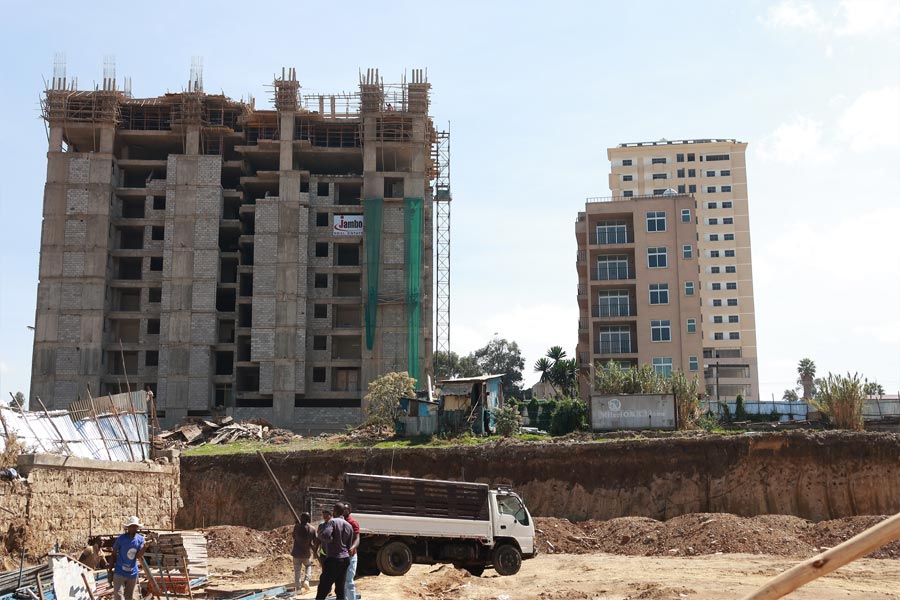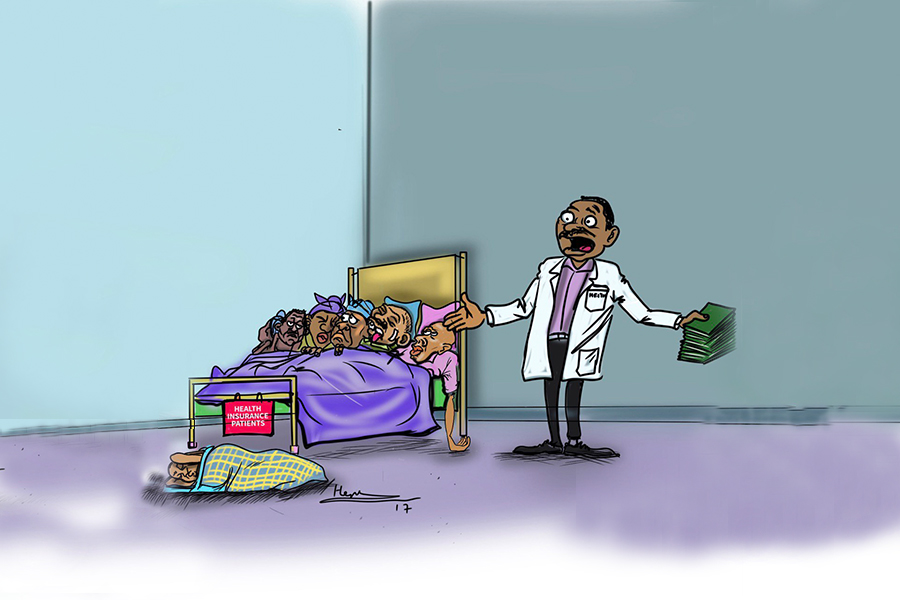
Radar | Oct 27,2024
The Cooperative Bank of Oromia (COOP-Oromia) has managed to carve out a significant growth course, distinguishing itself among the banking industry's elite with a robust 26.8pc jump in net profits to 2.6 billion Br.
Yet, this financial achievement comes with a nuanced backdrop as the Bank's Earnings Per Share (EPS) experienced a notable decline, moving down by four Birr to settle at 30, reflecting the complexities underlying its fiscal strategies and the broader economic environment. The past year was marked by global uncertainties and domestic economic pressures.
The Bank’s financial performance, particularly its profit growth amidst challenging global circumstances, including increased domestic conflicts and inflation, shows a strategic repositioning. The Bank's Board Chairman, Fikru Deksisa (PhD), told shareholders who gathered in Adama (Nazareth) town that COOP-Oromia’s ability to steer through these headwinds was successful.
The 18-year-old Bank posted 300 million Br higher profits than its peer Hibret, while it fell significantly short of Awash's 6.99 billion Br, Dashen's 3.5 billion or the Bank of Abyssinia's 3.87 billion Br.
However, the reduction in EPS, a critical measure of profitability for shareholders, suggests a contrasting narrative of dilution, primarily attributed to the Bank's aggressive capital expansion. Over the year, COOP’s paid-up capital saw a significant hike of 29.4pc, reaching a milestone of 10.02 billion Br, a strategic move aimed at fortifying the Bank's financial base but with immediate repercussions on shareholder returns.
Founding shareholders such as the Oromia Coffee Farmers Cooperative Union (OCFCU), with 273 million Birr shares, are feeling the pinch. Despite a notable increase in assets and loans, access to credit remains a challenge for the Union’s half-million farmers, according to Dejene Dadi, the Union's general manager. He criticised the Bank's conservative lending during crucial harvest periods, a view attributed to rising non-performing loans that have tightened liquidity.
The Bank reported a 22.5pc growth in total assets to 140.33 billion Br, with loans and advances also rising by 20.5pc to 99.67 billion Br. This expansion came amid a strategic shift, as COOP-Oromia liquidated investments in National Bank of Ethiopia (NBE) bills, reallocating gains from government securities. However, a significant loan disbursement spree — 29 billion Br between July and December — precipitated a liquidity crunch, a move that the Bank's senior executives described as "aggressive."
"It was an aggressive disbursement," Deribe Asfaw, the Bank's President, told Fortune.
COOP-Oromia's financial health, in comparison to its peers, paints a mixed picture. With a loan-to-deposit ratio of 85.7pc and a capital adequacy ratio slightly down to 12.5pc from 13.2pc, the liquidity level of the Bank decreased both in absolute and relative terms. These figures signal a cautious approach, especially when compared with larger banks such as Abyssinia and Awash banks, which boast more substantial loan portfolios. COOP-Oromia's efforts to manage liquidity and ensure stability are evident in its borrowing of 3.183 billion Br from the central bank, a move analysts like the London-based financial analyst Abdulmenan Mohammed (PhD) view indicate deeper liquidity concerns.
He considered the Bank's profit growth impressive but raised concerns over the consecutive drops in EPS that could disappoint its 21,700 shareholders, identifying capital expansion as the primary cause.
"The returns weren't that great," Dejene told Fortune.
Dejene was informed by Bank management that the increment in sick loans had created a cash squeeze, which did little to appease the appetite of the half a million farmers in the Union.
According to Abdulmenan, an aggressive expansion of capital likely caused the drop. The Bank’s President echoed his perspective and attributed the EPS dip to the increased allocations to risk reserves. Despite these, the analysts and executives maintain a positive outlook on the Bank's overall performance, implying a strategic calibration could reconcile growth with shareholder value.
"We're in good shape," said Deribe
A fourth President of Coop-Oromia since its incorporation in 2005, Deribe was appointed president in 2016. He replaced Wondmagegn Negera, now the CEO of the Ethiopian Commodity Exchange (ECX). Incorporated with the 112.04 million Br paid-up capital and 300 million Br subscribed, the Bank increased its workforce to 15,395, deployed in a network of 738 branches; COOP-Oromia's operational footprint has significantly widened.
The expansion reflects its physical presence and in its financial indicators, with total assets bolstering by 22.5pc to reach 140.33 billion Br and a proactive approach to loan and advance increases of 20.5pc, totalling 99.67 billion Br. COOP’s strategic posture is evidenced in its approach to revenue generation, which saw a diversified income stream contributing to its net profit growth. Interest income surged by 51.2pc to 12.22 billion Br, alongside notable increases in income from Murabaha financing (1.52 billion Br) and fees and commissions (1.94 billion Br), showing 59.2pc and 20.5pc growth, respectively.
Abdulmenan indicates that financial and non-financial intermediation revenues drove COOP's net profit growth.
"The growth of revenues is very impressive," he told Fortune. "The management of the Bank should be applauded."
Such financial vigour, however, is balanced by the Bank's cautious management of its loan portfolio, where provisions for impairment of loans soared by 53.5pc to 969.28 million Br, indicating a sharp focus on responding to credit risks amidst an uptick in non-performing loans (NPL). COOP-Oromia posted a far larger amount of provision than Oromia Bank's 70.2 million Br, Hibert (103.1 million Br), as well as Awash's and Bank of Abyssinia’s 242.97 million 960 million Br, respectively.
"This should be very concerning," said Abdulmenan. "The management needs to be watchful of questionable loans and advances,".
Deribe suggested that increasing the Bank's provisions in a bid to enhance risk managment became necessary due to several loans passing the 30-day payment deadline.
However, the Bank's Bole Medhanialem Branch manager, Sentayehu Feyisa, saw significant progress in forex mobilisation, introducing new products and high deposit mobilisation as defining COOP-Oromia over the past few years. He believes that the recent spike in growth emerged from prudent managment of the slowdown in business activities across the economy over the past few years when conflict and liquidity challenges became rampant.
"We focused on retaining our corporate customers," Sentayehu told Fortune.
Gains on foreign exchange also increased by 43.2pc to Br 1.89 billion Br, while the loss on the same operation increased by 26.8pc to Br 1.96 billion, undermining the gains, Abdulmenan observed.
"Our forex commitments grew alongside our gains," Deribe conceded.
The Bank's operational expenses have come under scrutiny, revealing a significant uptick across various categories, including interest expenses, wages, benefits, and other operating costs. This upward trend in expenditures is seen as a reflection of COOP-Oromia's aggressive expansion and investment in its workforce, but it raises concerns about the sustainability of its revenue growth at a time of rising costs.
A comparison with industry peers shows COOP-Oromia's wage expenses at 3.32 billion Br, positioning it below some of the industry's heavyweights like Awash Bank's nine billion Br, yet substantially above others like Hibret Bank's 2.71 billion Br. The Bank's strategic spending on human capital could be commendable, but Abdulmenan observed significant leaps in allowances and donations, which have soared to 768.96 million Br and 218.18 million Br, respectively, from much lower figures in the preceding period.
According to Abdulmenan, COOP-Oromia's management must rationalise the steep increase in these specific expenditure lines, stressing the need for a balanced approach to ensure operational spending aligns with strategic goals without compromising the Bank's financial performance.
"While the revenue growth is impressive, expansion of these expenses needs attention," he said.
The Bank's President blamed external pressures contributing to the rise in expenses, including the global increase in fuel prices impacting benefits packages and the higher commission fees tied to a surge in agent banking transactions. According to the President, these factors demand a cautious approach to large-scale procurements in the current fiscal year as part of a broader strategy to manage costs effectively.
"We're becoming careful about large procurements this year," Deribe told Fortune.
Despite not leading the pack in overall profitability — where COOP-Oromia still trails behind industry giants such as Awash, Dashen, and Abyssinia banks — its achievements, particularly in asset growth and market share, illustrated its robust market position. The Bank’s focus on leveraging its cooperative model for enhanced community engagement and customer retention offers a unique competitive edge that could define its future in a rapidly evolving financial sector.
Yet, the road ahead for COOP-Oromia is as much about charting its internal strategic plans as it is about adapting to the external economic realities. Experts see the Bank's ability to balance aggressive capital expansion with shareholder value, manage operational expenses against revenue growth, and mitigate credit risks amid an expanding loan portfolio will remain critical.
PUBLISHED ON
Feb 03,2024 [ VOL
24 , NO
1240]

Radar | Oct 27,2024

Fortune News | Mar 02,2024

My Opinion | Sep 03,2022

Radar | Nov 24, 2024

View From Arada | Jul 07,2024

Radar | Jul 13,2025

Radar | Apr 15,2023

Fortune News | Jun 10,2023

Agenda | Feb 24,2024

Radar | Sep 22,2024

Dec 22 , 2024 . By TIZITA SHEWAFERAW
Charged with transforming colossal state-owned enterprises into modern and competitiv...

Aug 18 , 2024 . By AKSAH ITALO
Although predictable Yonas Zerihun's job in the ride-hailing service is not immune to...

Jul 28 , 2024 . By TIZITA SHEWAFERAW
Unhabitual, perhaps too many, Samuel Gebreyohannes, 38, used to occasionally enjoy a couple of beers at breakfast. However, he recently swit...

Jul 13 , 2024 . By AKSAH ITALO
Investors who rely on tractors, trucks, and field vehicles for commuting, transporting commodities, and f...

Sep 6 , 2025
The dawn of a new year is more than a simple turning of the calendar. It is a moment...

Aug 30 , 2025
For Germans, Otto von Bismarck is first remembered as the architect of a unified nati...

Aug 23 , 2025
Banks have a new obsession. After decades chasing deposits and, more recently, digita...

Aug 16 , 2025
A decade ago, a case in the United States (US) jolted Wall Street. An ambulance opera...